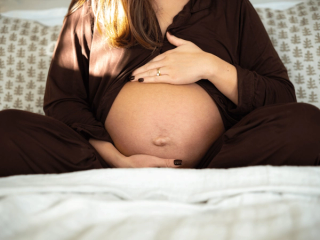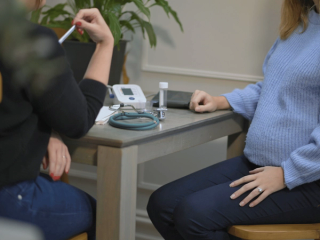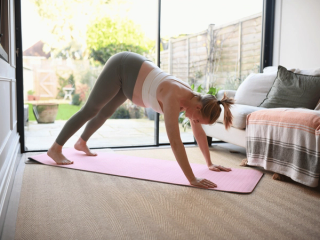
- Home
- Advice Hub
- Pregnancy
- Pregnancy Care
- Sleeping In The Third Trimester
Sleeping in the third trimester
Discover how to sleep better in the third trimester with our essential tips and tricks for mums to be. Ensure restful nights for a smooth pregnancy.
Reviewed by Christine Lane, Midwife and Consultant, on the 24.09.2025
Getting enough sleep during pregnancy can be a challenge, especially in the third trimester. Sleep in pregnancy is a bit of a paradox – while we know how important it is, it often comes with a host of disruptions. A growing belly, frequent trips to the bathroom, and general discomfort can all make it difficult to get the rest you need.
This guide will help you understand how sleep changes during the third trimester, why it's essential, and offer tips and recommended sleeping positions to help you rest better.
How sleep changes in the third trimester
As you enter the third trimester, your sleep patterns may shift. You might find yourself waking up more often during the night due to the following:
- Increased need to urinate - Your growing baby puts pressure on your bladder.
- Discomfort - Back pain, leg cramps, and heartburn become more common.
- Vivid dreams - Hormonal changes can lead to more intense and vivid dreams.
- Shorter sleep cycles - You may spend less time in deep sleep and more in lighter stages of sleep.
Why sleep is important in pregnancy
Getting good sleep during pregnancy supports both your wellbeing and your baby’s development. Rest helps your body recharge, supports a healthy immune system, and gives you the energy you need as your pregnancy progresses. Some research also suggests that regular, good-quality sleep may help maintain healthy blood pressure. It also supports good blood flow to the placenta, helping your baby grow and develop well.
Emotional wellbeing is important during pregnancy, and a lack of sleep can contribute to feelings of low mood and depression.
Sleeping in the third trimester tips
Everyone will find that different things may help them relax and enable a better night’s sleep, but here are some ideas that you may find beneficial:
- Relaxing bedtime routine - Establishing a calming bedtime routine can signal to your body that it’s time to wind down. Consider incorporating a warm bath and a calming book or audiobook.
- Pregnancy yoga - Pregnancy yoga is an excellent way to relieve tension and promote relaxation. Gentle stretches can help ease discomfort and improve sleep quality. Focus on poses that target lower back pain and hip discomfort.
- Limiting screen time - Electronic devices emit blue light, which can interfere with your body’s natural sleep-wake cycle. To improve your sleep, turn off all electronic devices at least an hour before bed. Create a restful environment by making your bedroom a screen-free zone and leaving electronics outside of the bedroom.
- Hypnobirthing - Hypnobirthing techniques can help you relax and prepare for labour. Some of the techniques that are taught in a hypnobirthing course may also help with sleeping such as guided meditations and breathing exercises.
- Use a pregnancy pillow – think about investing in a pregnancy pillow, not only will this aid a more restful night’s sleep, some can even be used as a nursing pillow too. Pregnancy pillows are designed to support the changing shape of your body as your pregnancy progresses. They come in a range of shapes, sizes and materials, so you should be able to find one that suits you. To help you choose the right pillow, you can read our pregnancy pillows guide.
Third trimester sleeping positions
Getting comfortable can become trickier as your bump grows in the third trimester. If you’re normally a belly sleeper, you might notice it becomes less comfortable over time. Lying flat on your back in late pregnancy isn’t usually recommended, as the weight of the uterus can press on a major blood vessel called the vena cava. This might make you feel lightheaded and can reduce blood flow slightly. Try settling on your side instead – it’s often more comfortable and can help support circulation for both you and your baby.
The optimal third trimester sleeping position is laying on your side, preferably the left side. We move around a lot during nighttime sleep, so if you wake up and find yourself sleeping on your back, don’t panic, just roll back over to your side. Laying on your left side in the third trimester can help to enhance blood flow to the placenta, and can help to reduce pressure on your liver and kidneys, lowering the chance of swelling in your ankles, feet and hands.
Placing a pregnancy pillow between your knees when you sleep can be a game changer. Here’s how it can help:
- Support for the belly - Helps support the weight of your growing belly.
- Relieves pressure - Reduces pressure on your back and hips by aligning your body.
- Improves comfort – Promotes the recommended side sleeping position
If you are able to spend time at home or on maternity leave in the final weeks of pregnancy, take the opportunity to have naps where possible during the day. You’ll likely be feeling exhausted, and this can help, particularly if you are not getting enough at night.
Navigating sleep during the third trimester can be challenging, but with the right strategies, you can work towards improving your sleep quality. Establishing a relaxing bedtime routine, incorporating pregnancy yoga, avoiding electronics, and using hypnobirthing techniques can all contribute to better sleep. Additionally, adopting the recommended side-sleeping positions with the help of a pregnancy pillow can enhance your comfort and ensure you get the rest you need.







